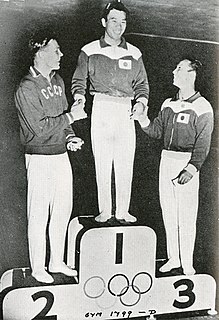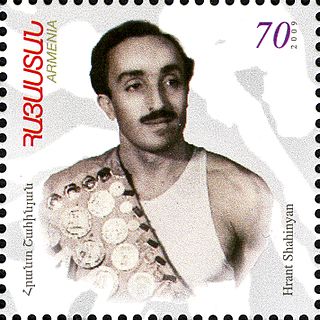
The men's vault competition was one of eight events for male competitors in artistic gymnastics at the 1960 Summer Olympics in Rome. It was held on 5, 7, and 10 September at the Baths of Caracalla. There were 129 competitors from 28 nations, with nations in the team competition having up to 6 gymnasts and other nations entering up to 2 gymnasts. For the second straight Games, there was a tie for first place in the vault. Boris Shakhlin of the Soviet Union and Takashi Ono of Japan each received a gold medal. It was the third consecutive Games with a gold medal for the Soviets. Ono, who had taken bronze in 1952, became the second man to win multiple vault medals. Third place and the bronze medal went to Soviet Vladimir Portnoi.
These are the results of the men's floor competition, one of eight events for male competitors in artistic gymnastics at the 1960 Summer Olympics in Rome.

The men's vault competition was one of eight events for male competitors in artistic gymnastics at the 1956 Summer Olympics in Melbourne. It was held from 3 to 7 December at the Melbourne Festival Hall. There were 63 competitors from 18 nations, with nations in the team competition having up to 6 gymnasts and other nations entering up to 3 gymnasts. The event was won by Helmut Bantz of the United Team of Germany and Valentin Muratov of the Soviet Union, who tied for the top place. Soviet Yuri Titov finished third to win the bronze medal.
These are the results of the men's floor competition, one of eight events for male competitors in artistic gymnastics at the 1956 Summer Olympics in Melbourne.
These are the results of the women's floor competition, one of six events for female competitors in artistic gymnastics at the 1956 Summer Olympics in Melbourne.

The men's horizontal bar competition was one of eight events for male competitors in artistic gymnastics at the 1956 Summer Olympics in Melbourne. There were 63 competitors from 18 nations, with nations in the team competition having up to 6 gymnasts and other nations entering up to 3 gymnasts. The event was won by Takashi Ono of Japan, with his countryman Masao Takemoto taking bronze. Silver went to Yuri Titov of the Soviet Union. Japan and the Soviet Union each earned their first horizontal bar medals.

The men's rings competition was one of eight events for male competitors in artistic gymnastics at the 1956 Summer Olympics in Melbourne. It was held from 3 to 7 December at the Melbourne Festival Hall. There were 63 competitors from 18 nations, with nations in the team competition having up to 6 gymnasts and other nations entering up to 3 gymnasts. The event was won by Albert Azaryan of the Soviet Union, the nation's second consecutive victory in the rings. Another Soviet, Valentin Muratov, took silver. Masumi Kubota and Masao Takemoto earned Japan's first medals in the event, tying for bronze.
These are the results of the women's artistic individual all-around competition, one of six events for female competitors in artistic gymnastics at the 1956 Summer Olympics in Melbourne.

The men's parallel bars competition was one of eight events for male competitors in artistic gymnastics at the 1956 Summer Olympics in Melbourne. It was held from 3 to 7 December at the Melbourne Festival Hall. There were 63 competitors from 18 nations, with nations in the team competition having up to 6 gymnasts and other nations entering up to 3 gymnasts. The event was won by Viktor Chukarin of the Soviet Union, the nation's first victory in the parallel bars. Japan took three medals: a silver by Masumi Kubota and bronzes by Takashi Ono and Masao Takemoto. It was the third time a nation had won three medals in the event in the same Games: the United States had swept the medals in 1904 and Switzerland had earned a gold and two bronzes in 1948. Chukarin was the third man to win multiple medals in the parallel bars; Ono would become the fourth in 1960.

The men's pommel horse competition was one of eight events for male competitors in artistic gymnastics at the 1956 Summer Olympics in Melbourne. It was held from 3 to 7 December at the Melbourne Festival Hall. There were 63 competitors from 18 nations, with nations in the team competition having up to 6 gymnasts and other nations entering up to 3 gymnasts. The event was won by Boris Shakhlin of the Soviet Union, the nation's second consecutive victory in the pommel horse. Takashi Ono earned Japan's first medal in the event with his silver. Soviet Viktor Chukarin became the first man to win multiple medals in the pommel horse, adding a bronze to his 1952 gold.
These are the results of the men's team all-around competition, one of eight events for male competitors in artistic gymnastics at the 1960 Summer Olympics in Rome.
The men's artistic team all-around competition at the 1952 Summer Olympics was held at the Messuhalli, Exhibition Hall I on 19 and 21 July. It was the tenth appearance of the event.
The women's artistic team all-around competition at the 1952 Summer Olympics was held at Messuhalli, Exhibition Hall II on 22–24 July. It was the fourth appearance of the event.

The men's artistic individual all-around competition at the 1952 Summer Olympics was held at Messuhalli, Exhibition Hall I from 19 to 21 July. It was the eleventh appearance of the event. There were 185 competitors from 29 nations. Each nation entered a team of between five and eight gymnasts or up to three individual gymnasts. The event was won by Viktor Chukarin of the Soviet Union, with his countryman Hrant Shahinyan taking silver. It was the Soviet debut in the event, beginning four decades of dominance rivalled only by Japan and ending only after the dissolution of the Soviet Union; the Soviets would win 6 of the 10 editions from 1952 to 1988, with Japan taking the other 4. Bronze in 1952 went to Josef Stalder of Switzerland ; it was the last medal in the men's all-around for any gymnast not from the Soviet Union or Japan until 1980.
The women's artistic individual all-around competition at the 1952 Summer Olympics was held at Messuhalli, Exhibition Hall II from 22 to 23 July. It was the first appearance of the event.

The men's artistic individual all-around competition at the 1956 Summer Olympics was held at the West Melbourne Stadium from 3 to 7 December. It was the twelfth appearance of the event. There were 63 competitors from 18 nations, with each nation entering up to 6 gymnasts. The event was won by Viktor Chukarin of the Soviet Union, the second man to successfully defend an all-around title and fourth to earn multiple medals of any color. His countryman Yury Titov took bronze. Takashi Ono of Japan earned silver. It was the first medal in the event for Japan, beginning that nation's nearly four-decade battle with the Soviet Union for dominance. Every men's all-around medal from 1956 to 1976 was won by a gymnast from one of those two nations; from 1952 to 1988, the Soviets won 6 of the 10 gold medals while Japan won the other 4.
The men's floor exercise competition at the 1952 Summer Olympics was held at Messuhalli, Exhibition Hall I from 19 to 21 July. It was the fourth appearance of the event.
The women's floor exercise competition at the 1952 Summer Olympics was held at Messuhalli, Exhibition Hall II from 22 to 23 July. It was the first appearance of the event.
The women's vault competition at the 1952 Summer Olympics was held at Messuhalli, Exhibition Hall II from 22 to 23 July. It was the first appearance of the event, though vault exercises were part of the women's team all-around events in 1928, 1936, and 1948.
The women's artistic team all-around competition at the 1956 Summer Olympics was held at the West Melbourne Stadium from 3 to 7 December. It was the 5th appearance of the event.





